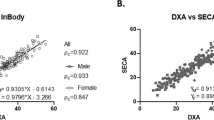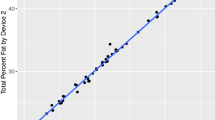Abstract
Background/Objectives:
We evaluated the agreement of air displacement plethysmography (ADP) and bioelectrical impedance analysis (BIA) with dual-energy X-ray absorptiometry (DXA) for the assessment of percent fat mass (%FM) in morbidly obese women.
Subjects/Methods:
Fifty-seven women aged 19–55 years and with a body mass index (BMI) ranging from 37.3 to 55.2 kg/m2 were studied. Values of %FM were obtained directly from ADP and DXA, whereas for BIA we estimated fat-free mass (FFM) from an equation for morbidly obese subjects and calculated %FM as (weight−FFM)/weight.
Results:
The mean (s.d.) difference between ADP and DXA for the assessment of %FM was −2.4% (3.3%) with limits of agreement (LOA) from −8.8% to 4.1%. The mean (s.d.) difference between BIA and DXA for the assessment of %FM was 1.7% (3.3%) with LOA from −4.9% to 8.2%.
Conclusion:
ADP–DXA and BIA–DXA are not interchangeable methods for the assessment of body composition in morbidly obese women.
This is a preview of subscription content, access via your institution
Access options
Subscribe to this journal
Receive 12 print issues and online access
$259.00 per year
only $21.58 per issue
Buy this article
- Purchase on Springer Link
- Instant access to full article PDF
Prices may be subject to local taxes which are calculated during checkout


Similar content being viewed by others
References
Das SK . Body composition measurement in severe obesity. Curr Opin Clin Nutr Metab Care 2005; 8: 602–606.
Coppini LZ, Waitzberg DL, Campos ACL . Limitations and validation of bioelectrical impedance analysis in morbidly obese patients. Curr Opin Clin Nutr Metab Care 2005; 8: 329–332.
Sartorio A, Malavolti M, Agosti F, Marinone PG, Caiti O, Battistini N et al. Body water distribution in severe obesity and its assessment from eight-polar bioelectrical impedance analysis. Eur J Clin Nutr 2005; 59: 155–160.
Kanellakis S, Kourlaba G, Moschonis G, Vandorou A, Manios Y . Development and validation of two equations estimating body composition for overweight and obese postmenopausal women. Maturitas 2010; 65: 64–68.
Berstad P, Randby A, Seim Ekeland G, Ulveland H, Omland T, Almendingen K . Body fat and fat-free mass measured by bioelectric impedance spectroscopy and dual-energy X-ray absorptiometry in obese and non-obese adults. Br J Nutr 2012; 107: 1192–1200.
Pietrobelli A, Formica C, Wang Z, Heymsfield SB . Dual-energy X-ray absorptiometry body composition model: review of physical concepts. Am J Physiol 1996; 271: E941–E951.
Lee SY, Gallagher D . Assessment methods in human body composition. Curr Opin Clin Nutr Metab Care 2008; 11: 566–572.
Williams JE, Wells JCK, Wilson CM, Haroun D, Lucas A, Fewtrell MS . Evaluation of lunar prodigy dual-energy x-ray absorptiometry for assessing body composition in healthy persons and patients by comparison with the criterion 4-component model. Am J Clin Nutr 2006; 83: 1047–1054.
Kelly TL, Wilson KE, Heymsfield SB . Dual energy X-ray absorptiometry body composition reference values from NHANES. PLoS One 2009; 4: e7038.
Cornier M-A, Després J-P, Davis N, Grossniklaus DA, Klein S, Lamarche B et al. Assessing adiposity: a scientific statement from the American Heart Association. Circulation 2011; 124: 1996–2019.
Fields DA, Goran MI, McCrory MA . Body-composition assessment via air-displacement plethysmography in adults and children: a review. Am J Clin Nutr 2002; 75: 453–467.
Ginde SR, Geliebter A, Rubiano F, Silva AM, Wang J, Heshka S et al. Air displacement plethysmography: validation in overweight and obese subjects. Obes Res 2005; 13: 1232–1237.
Le Carvennec M, Fagour C, Adenis-Lamarre E, Perlemoine C, Gin H, Rigalleau V . Body composition of obese subjects by air displacement plethysmography: the influence of hydration. Obesity 2007; 15: 78–84.
Geliebter A, Atalayer D, Flancbaum L, Gibson CD . Comparison of body adiposity index (BAI) and BMI with estimations of % body fat in clinically severe obese women. Obesity 2013; 21: 493–498.
Horie LM, Barbosa-Silva MCG, Torrinhas RS, de Mello MT, Cecconello I, Waitzberg DL . New body fat prediction equations for severely obese patients. Clin Nutr 2008; 27: 350–356.
Jiménez A, Omaña W, Flores L, Coves MJ, Bellido D, Perea V et al. Prediction of whole-body and segmental body composition by bioelectrical impedance in morbidly obese subjects. Obes Surg 2012; 22: 587–593.
Lazzer S, Bedogni G, Agosti F, De Col A, Mornati D, Sartorio A . Comparison of dual-energy X-ray absorptiometry, air displacement plethysmography and bioelectrical impedance analysis for the assessment of body composition in severely obese Caucasian children and adolescents. Br J Nutr 2008; 100: 918–924.
Guo SS, Chumlea WC, Cockram DB . Use of statistical methods to estimate body composition. Am J Clin Nutr 1996; 64 (3 Suppl), 428S–435S.
Deurenberg P . Limitations of the bioelectrical impedance method for the assessment of body fat in severe obesity. Am J Clin Nutr 1996; 64 (3 Suppl), 449S–452S.
Lohman TG, Roche AF, Martorell R . Anthropometric Standardization Reference Manual. Human Kinetics Books: Champaign, IL, USA, 1988.
World Health Organization (WHO). Obesity: Preventing and Managing the Global Epidemic. Report of a WHO Consultation. World Health Organization: Geneva, 2000.
Siri WE . Body composition from fluid spaces and density: analysis of methods. 1961. Nutrition 1993; 9: 480–491.
Deurenberg P . International consensus conference on impedance in body composition. Age Nutr 1994; 5: 142–145.
Royston P, Sauerbrei W . Multivariable Model-Building: A Pragmatic Approach to Regression Analysis Based on Fractional Polynomials for Modelling Continuous Variables. Wiley: Chichester, UK, 2008.
Bland JM, Altman DG . Measuring agreement in method comparison studies. Stat Methods Med Res 1999; 8: 135–160.
Carstensen B . Comparing Clinical Measurement Methods: A Practical Guide. Wiley: Chichester, UK, 2010.
Bertoli S, Battezzati A, Testolin G, Bedogni G . Evaluation of air-displacement plethysmography and bioelectrical impedance analysis vs dual-energy X-ray absorptiometry for the assessment of fat-free mass in elderly subjects. Eur J Clin Nutr 2008; 62: 1282–1286.
Prado CMM, Wells JCK, Smith SR, Stephan BCM, Siervo M . Sarcopenic obesity: a critical appraisal of the current evidence. Clin Nutr 2012; 31: 583–601.
Heymsfield SB, Lichtman S, Baumgartner RN, Wang J, Kamen Y, Aliprantis A et al. Body composition of humans: comparison of two improved four-compartment models that differ in expense, technical complexity, and radiation exposure. Am J Clin Nutr 1990; 52: 52–58.
Das SK, Roberts SB, Kehayias JJ, Wang J, Hsu LKG, Shikora SA et al. Body composition assessment in extreme obesity and after massive weight loss induced by gastric bypass surgery. Am J Physiol Endocrinol Metab 2003; 284: E1080–E1088.
Wang Z, Deurenberg P, Wang W, Pietrobelli A, Baumgartner RN, Heymsfield SB . Hydration of fat-free body mass: new physiological modeling approach. Am J Physiol 1999; 276 (6 Pt 1), E995–E1003.
Hull H, He Q, Thornton J, Javed F, Allen L, Wang J et al. IDXA, prodigy, and DPXL dual-energy X-ray absorptiometry whole-body scans: a cross-calibration study. J Clin Densitom 2009; 12: 95–102.
Steyerberg EW . Clinical Prediction Models: A Practical Approach to Development, Validation, and Updating. Springer: New York, NY, USA, 2009.
Kriemler S, Puder J, Zahner L, Roth R, Braun-Fahrländer C, Bedogni G . Cross-validation of bioelectrical impedance analysis for the assessment of body composition in a representative sample of 6- to 13-year-old children. Eur J Clin Nutr 2009; 63: 619–626.
Acknowledgements
We thank the women for their participation in the study. We are also grateful to the head nurse and the nursing staff at the Division of Metabolic Diseases of Istituto Auxologico Italiano (Verbania, Italy), and to Dr Alessandra Patrizi for their help with the recruitment of women. The study was supported by Progetti di Ricerca Corrente, Istituto Auxologico Italiano, Verbania and Milan, Italy.
Author information
Authors and Affiliations
Corresponding author
Ethics declarations
Competing interests
The authors declare no conflict of interest.
Rights and permissions
About this article
Cite this article
Bedogni, G., Agosti, F., De Col, A. et al. Comparison of dual-energy X-ray absorptiometry, air displacement plethysmography and bioelectrical impedance analysis for the assessment of body composition in morbidly obese women. Eur J Clin Nutr 67, 1129–1132 (2013). https://doi.org/10.1038/ejcn.2013.159
Received:
Revised:
Accepted:
Published:
Issue Date:
DOI: https://doi.org/10.1038/ejcn.2013.159
Keywords
This article is cited by
-
A new anthropometric index for body fat estimation in patients with severe obesity
BMC Obesity (2018)
-
Practical Considerations for Body Composition Assessment of Adults with Class II/III Obesity Using Bioelectrical Impedance Analysis or Dual-Energy X-Ray Absorptiometry
Current Obesity Reports (2016)
-
Relationship between glucose metabolism and non-alcoholic fatty liver disease severity in morbidly obese women
Journal of Endocrinological Investigation (2014)



